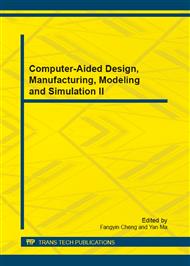[1]
Li Daopin. Development of low-permeability sandstone oil field [M]. Beijing: Petroleum industry press, (1997).
Google Scholar
[2]
Li Jian, Wu Zhiyong. Exploration and development technology in deep-layer tight sandstone gas reservoir [M]. Beijing: Petroleum industry press, (2002).
Google Scholar
[3]
Translated by Gong Zhengyong. Geology of tight gas reservoir [M]. Harbin: Heilongjiang Science and Technology Press , 1991: 57-93.
Google Scholar
[4]
Ma Xinhua, Wang Tao, Pang Xiongqi , et al. Physical simulation experiment and explanation of gas accumulation mechanism in the deep basin gas accumulation region and its high-permeability sand block [J] PETROLEUM GEOLOGY AND EXPERIMENT, 2004, 26(4): 383-388.
Google Scholar
[5]
Zhao Chenglin, Chen Lihua, Tu Qiang , et al. China gas reservoir [M]. Beijing: Petroleum industry press, 1999: 1-5.
Google Scholar
[6]
Jiang Zhenxue, Lin Shiguo, Pang Xiongqi, et al. The comparison of two types of tight sandstone gas reservoir [J]. Petroleum Geology & Experiment, 2006, 28(3): 210-214.
Google Scholar
[7]
KEITH W. SHANLEY, ROBERT M. CLUFF, JOHN W. ROBINSON, 2004, Factors controlling prolific gas production from low-permeability sandstone reservoirs: Implications for resource assessment, prospect development, and risk analysis, v. 88, pp.1083-1116.
DOI: 10.1306/03250403051
Google Scholar
[8]
KEITH W. SHANLEY, ROBERT M. CLUFF, JOHN W. ROBINSON, 2004, Factors controlling prolific gas production from low-permeability sandstone reservoirs: implications for resource assessment, prospect development, and risk analysis, v. 88, pp.1083-1116.
DOI: 10.1306/03250403051
Google Scholar
[9]
Wu gang, Diagenesis of low- permeability sandstone reservoir and prediction of the advantageous reservoir area [J]., 2004, 16(4): 5-8.
Google Scholar
[10]
MASTER,J.A., 1979, Deep basin gas trap, western Canada: AAPG Bulletin, v. 63, pp.152-181.
Google Scholar
[11]
MASTER,J.A., 1979, Deep basin gas trap, western Canada: AAPG Bulletin, v. 63, pp.152-181.
Google Scholar
[12]
Zhang shuguang, Shi Jingping, Liu Qingju, et al, Research on pore structure and character of tight sand gas reservoirs [j], Xinjiang Geology, 2004, 22(4): 438-441.
Google Scholar
[13]
JONES F O, OWENS W W. A laboratory study of low permeability gas sands[J]. JPT. 1980, 32(9): 1631-1640.
DOI: 10.2118/7551-pa
Google Scholar
[14]
Jones f o, owens w w. A laboratory study of low permeability gas sands[j]. Jpt. 1980, 32(9): 1631-1640.
DOI: 10.2118/7551-pa
Google Scholar
[15]
Liu Shuxuan. Prediction of deep reservoir and phase of hydrocarbon. [M]. Beijing: Petroleum industry press, 1992: 10-45. 92-96.
Google Scholar
[16]
Lei Kaiqiang , Kong Fanzheng, Zhang Xiaonan, et al. Diagenesis and its storage capacity analysis of sandstone in the upper Paleozoic in Tabamiao area [j]. Mineralogy and Petrology, 2003, 23(3): 92-96.
Google Scholar
[17]
Wang Jinqi. The chimney effects of hydrocarbon activity. petroleum geology and experiment , [J]. 1979, (3): 193-200.
Google Scholar
[18]
Li Peng, Kang Yili, You Lijun, et al. Potential on aqueous trapping damage of tight sandstone gas reservoirs in Guandu Gas field, southeast Sichuan Basin[J], Petroleum geology and recovery efficiency, 2007, 14(4): 88-94.
Google Scholar
[19]
Liao Ruiquan, Xu Yonggao, Hu Xuebin, et al., Damage to low-permeability reservoir by water locking effect and its inhibiting and removing methods [J], Natural gas industry, 2002, 22(6): 87-89.
Google Scholar


